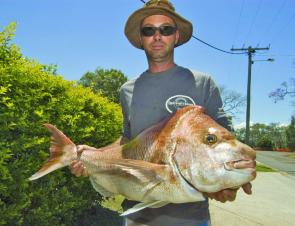The last couple of summers in the Southern Bay have had big runs of snapper and so far this summer has not disappointed. Anglers have been catching good numbers of big reds with couple of 20lb+ fish caught as well.
Deeper water seems to produce best for big snapper in summer. The shallows hold plenty of 35-60cm fish but most of the bigger fish you hook will bust you off around a lump of coral. Some good places to start hunting a big red include the deep holes between Coochiemudlo and Macleay islands, between the Spit Beacon at Peel and Cleveland Point, Harry Atkinsons Artificial and patches of reef off the western side of Mud Island.
Lure fishers should try using larger than normal soft plastics in the 5-6” range. The same slow hopping retrieve that works on smaller snapper will work on the bigger fish, but it pays to have another plastic on a 14g jighead just dead drifting out the back. Lures such as the 5” Berkley Gulp Jerkshad in lime tiger and nuclear chicken, and the Zoom 5” Superfluke in baby bass and rainbow shad colours have been very successful. The Assassin 7” Fluke has also a proven to be big fish taker. Early to mid-morning is quite productive in the summer months but on heavy boat traffic days, a pre-dawn session can pay off handsomely
Bait fishing for snapper in summer can be frustrating, with sharks and rays eating the baits before the target species can get a look in. A good way around this is to fish with large prawn baits that are less desirable to the Noahs. Another technique is to ‘float’ the bait down to the fish by constantly feeding line out, using the smallest possible sinker. This is the same as fishing floater baits offshore, just with lighter tackle. It allows the bait to drift around naturally, slowly sinking and giving the fish plenty of time to intercept the bait before it reaches the bottom.
Circle hooks like the Gamakatsu Octopus Circle and the Mustad Demon Fine Wire are gaining in popularity as it allows the fish to swim off and hook itself without the angler needing to strike and set the hook. Because the circle hooks lodge in the corner of the jaw and not down the throat, an angler can also get away with using much lighter leaders than usual which encourages more bites. The best times to fish are a couple of hours either side of the turn of the tide in the early hours of the morning. It’s either a very early start or a very late finish, but it does keep you clear of the Christmas holiday boat traffic.
While some people consider sharks to be vermin in the Bay, the prospect of tangling with a whaler or two will be exciting for others. The black tip whaler sharks are one of the best eating fish around and all species in the whaler/bull shark family are great sport. Nothing too fancy is needed to tackle most sharks in the bay and rivers, just a medium weight rod and reel with a smooth drag and capacity for 200m of 6-10kg line. Oily baits such as mullet and tuna fillets are popular but some of the really keen shark anglers also use eel and stingray pieces. Hooks don’t need to be outrageously big, just matched to the size of the bait and a wire trace or heavy mono leader completes the picture.
Other species to look out for in January include summer whiting in among the Southern Bay islands, spotty mackerel off Peel and Goat islands and mangrove jacks up the creeks. Just remember during the holiday period to take care on the water with all the extra boats about and if you are serious about catching fish at this time of year, try to focus your efforts around the times when most other people are either asleep or off the water.
Until next month, tight lines.
For more information on the southern Moreton Bay area, come and see me at Fish Head (Cnr Broadwater Tce and Stradbroke St, Redland Bay, www.fishhead.com.au) or call us on (07) 3206 7999.
Reads: 4477
Popper fishing the shallow reefs frequently turns up kingfish like this. Aaron Concord caught this one on a Chug Bug

Snapper of this size are around in Summer time. Nathan Guy caught this one on a Zoom Superfluke.

Darren Black with 10 kilos of bay snapper, caught on a lime tiger Gulp Jerkshad.




